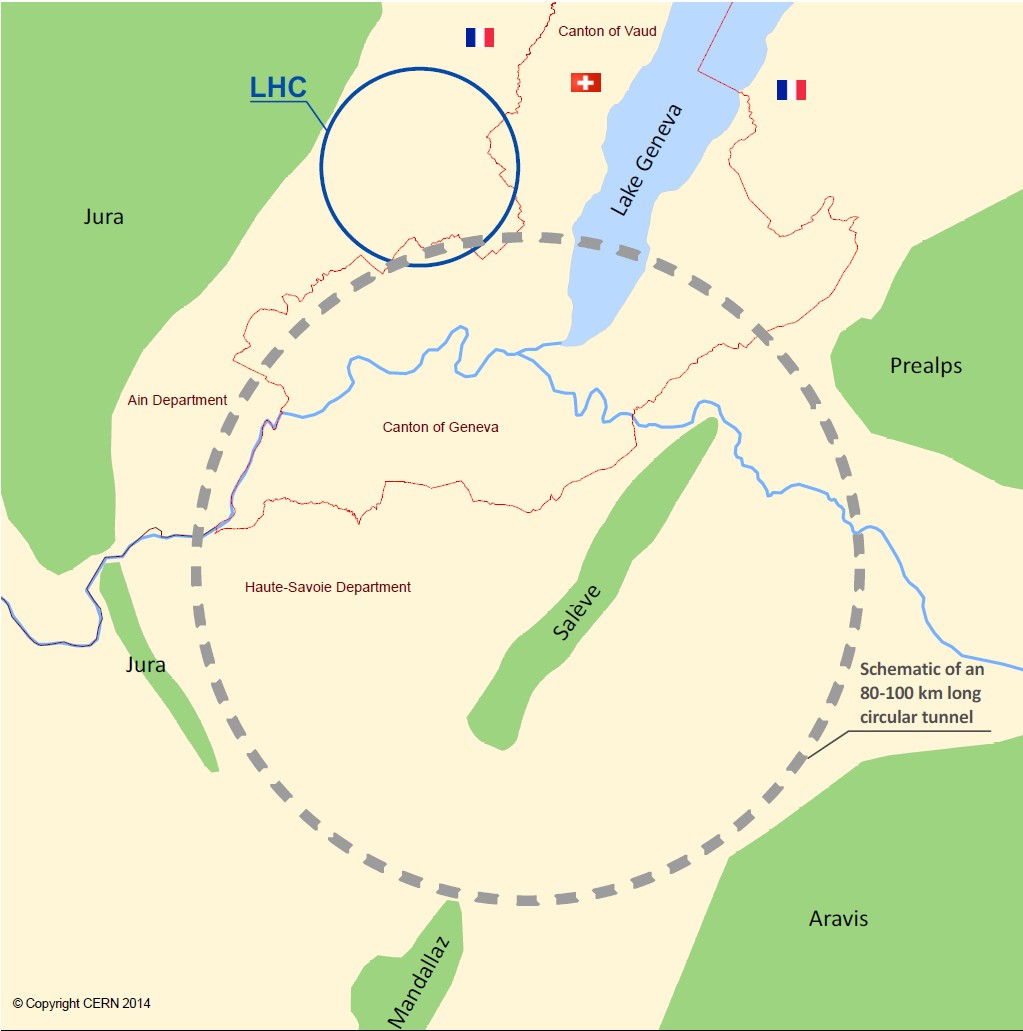A future proton-proton collider
The very stimulating FCC kick-off meeting was an occasion to discuss preliminary ideas about the physics case and potential of a 100 TeV proton-proton collider (FCC-hh), the experimental challenges and possible detector layouts. The FCC-hh activity started in November 2013. It already benefitted a lot from previous and ongoing efforts elsewhere in the world, including studies in the US (see e.g. http://www.snowmass2013.org) and China (see e.g. http://indico.ihep.ac.cn/conferenceDisplay.py?confId=3813). Links have been established with these communities and international collaboration in the FCC-hh studies is being strongly pursued.
The very successful LHC Run 1 has allowed the Standard Model to be completed, with the discovery of a Higgs boson, and consolidated, with a huge number of measurements at √s =7-8 TeV. It works beautifully. However, the outstanding questions (dark matter, matter/antimatter asymmetry, the naturalness of the Higgs boson mass, etc.) are still there, exacerbated by the lack of evidence (as yet) of new physics. These questions, and the need to study the recently-discovered Higgs boson in more details, call imperatively for the full exploitation of the LHC, the present “energy-frontier” accelerator, including its high-luminosity phase (HL-LHC).

Schematics of the 80-100 km circular tunnel that could house a Future Circular Collider (grey dotted line) and the LHC (blue tunnel) (Image Credit: CERN)
A future proton-proton collider with centre-of-mass energy around 100 TeV and integrated luminosities in the range 1-10 ab-1 offers the potential to: explore new physics with a direct discovery potential for new particles extending up to ~ 50 TeV; provide the ultimate elucidation of the electroweak symmetry breaking mechanism (beyond the sensitivity of the HL-LHC and 0.24-1 TeV e+e- colliders) through the study of Higgs boson pair production and gauge-boson scattering at high mass.
What would be the physics case for such an unprecedented and extremely challenging machine? Two scenarios can be identified:
- If new physics is discovered at the (HL-)LHC, its mass spectrum is expected to be quite heavy (as no evidence of such physics exists at √s= 8 TeV). The high-lying states may therefore not be accessible to the LHC. The physics motivation for a 100 TeV pp collider would the very strong in this case as such a machine could complete (or significantly advance) the exploration of the new physics by discovering the missing particles and making detailed studies of it. If no new physics is discovered at the (HL-)LHC but it (or experiments at other facilities) provides (indirect) evidence for the energy scale of new physics to be in the 10-50 TeV region, again, a 100 TeV collider would be a strongly compelling machine, as it would allow direct exploration of the scale of new physics.
- If no new physics is discovered at the (HL-)LHC, nor is there any experimental evidence that the scale of new physics is in the 10-50 TeV range, a 100 TeV pp collider would be the only accelerator allowing a significant jump in energy, and therefore exploration of a totally new territory. The present open questions in fundamental physics and in our understanding of the universe are crucial enough, difficult enough, and intertwined enough, to be addressed with a multitude of approaches: high-energy accelerators, neutrino experiments, underground detectors looking for dark matter and proton decay, cosmic surveys, high-energy cosmic-ray, gamma-rays and neutrino observatories, etc. Some of them can only be solved through the direct exploration of the 10-100 TeV scale, i.e. an energy regime where electroweak symmetry is unbroken. Therefore, abandoning one of the most successful roads of exploration so far, high-energy colliders, because they are “too difficult and too expensive” is not the right attitude for us scientists. Rather, we should use our creativity to invent and develop new technologies, or pushing the existing ones, to make such accelerators technically and financially affordable. As repeatedly shown in the past, these technologies would also have the potential to be transformative for society.
Concerning the detector design, the two main physics thrusts of a 100 TeV pp collider mentioned above present different, and in some cases conflicting, requirements. Searches for new physics at the highest achievable masses call for the largest possible integrated luminosity (which may entail operating in even harsher pile-up conditions than the HL-LHC) and a detector geometry à la ATLAS and CMS, as heavy particles are mainly produced in the central region. The biggest challenge will be to achieve a muon momentum resolution at the level of about 10% (i.e. a similar to that of ATLAS and CMS at 1 TeV) in the 10-20 TeV range. This will likely require magnets and detectors up to a factor of two bigger. First ideas for the magnet configurations have been presented at the kick-off meeting. Detailed studies of the Higgs boson, on the other hand, would require high-precision calorimetry and tracking (inside magnetic field) extending to the very forward regions (up to pseudo-rapidity |η|~5, to be compared to |η|~2.5 in ATLAS and CMS today), as the production of “light” particles (H, W, Z) at √s=100 TeV is much flatter than at √s =14 TeV. A dipole-like geometry à la LHCb (with two arms) has been suggested for the forward regions of the FCC-hh detectors.
Many extremely interesting physics and detector studies will be pursued in the coming months and years in view of the FCC Conceptual Design Report. Ideas, vision and creativity, and the right blend of dreams, ambition and realism, will be needed to develop the physics case and potential, optimize the accelerator parameters together with the machine experts, and conceive unprecedented experiments ab initio.
The “Hadron collider physics, experiments, interface, integration” activity of the FCC project is presently coordinated by Austin Ball, Fabiola Gianotti and Michelangelo Mangano. Please contact them if you wish to contribute, and/or subscribe to the mailing list fcc-experiments-hadron@cern.ch.
Conveners of the FCC-hh Physics and Experiments group for the FCC Kick-off & Study Preparation Team are: Austin Ball, Fabiola Gianotti and Michelangelo Mangano
